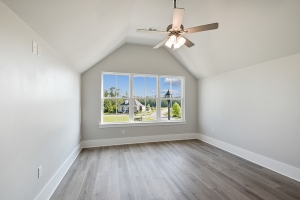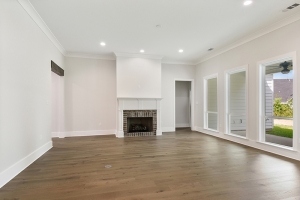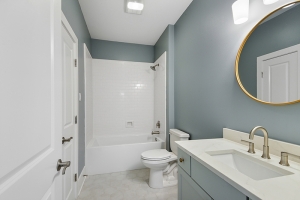1. Exterior
Not every defect is noticeable on the exterior of a home. A good
home inspector will look for cracks, peeling or damaged siding. This
includes looking for stains, old paint or peeling paint. They will look
to see if you have a clearance between the ground and siding materials
on the walls. This also leads to an inspector checking to make sure
there are no climbing vines going up the wall or that trees are planted
too close to the home. The last thing will be to make sure the windows,
doors and flashings are in working order and the vents and hoods
installation is done properly.
2. Roof/Attic
A bad or damaged roof can lead to big problems. An inspector will
inspect not only the exterior roof but also the attic. They want to
make sure that the structure and integrity of the roof and roofing
materials are strong. They will inspect what type of shingles are used,
the conditions of the shingles, if there is proper flashing, the
condition of the vents, and the chimney condition on the roof. In the
attic, they will inspect the insulation, the soffit vents, gable vents,
ridge vents, exhaust vents, appliance vents and the electrical splices.
They will make sure there is no evidence of damage or decay and look
for water spots or staining.
3. Foundation/Grounds
When inspecting the home inspector will make sure the foundation is
in good shape. They will look for proper grading (drainage) away from
the base of the home, standing water near the home or in the yard, the
condition of the gutters and the downspouts, and make sure the
downspouts and the gutters are directing water away from the
foundation. Also, any sheds, detached garages, fences or any other
structure in your yard will be inspected making sure they are in good
condition and free from rot or termite damage. They will also make sure
that the driveways and sidewalks are not cracking or shifting.
4. You definitely want the interior of your home to be kept up and damage-free.
There will be normal wear and tear, but an inspector takes this into
consideration. They will make sure the walls and ceilings are painted
and in good condition. Other things will note are cracks on the walls or
ceilings, cracked windows, doors incorrectly closing and opening and
not sealed, moisture spots, and level flooring with no moisture or soft
spots.
5. Structure
A very important part of the inspection involves the bones of the
house. An inspector wants to make sure it is liveable. They will make
sure:
-Foundation is in good condition – if the foundation is cracked or
shifting this will affect the structural integrity of the home
-Door frames are straight allowing doors to swing in and out of the frame with ease
-Window frames are straight on all four sides & without gaps
-Ridge and fascia board lines are level & straight
-Baseboards around all interior walls are flush with the flooring & not lifting or separated
-Flooring (especially hardwood) is flat and not bowed or lifting
-Exterior walls are straight and free of bowing or sagging
-Digitally measure the foundation to see if it is flat and level
6. Electrical
An electrical problem can not only be a fire hazard but can be very expensive to repair. They will make sure:
-DIY repair jobs – electrical systems should never be DIY jobs as this can cause significant damage to the entire system
-Light switches work & all bulbs light up (a bulb that isn’t lit may
just need to be replaced, but can also mean faulty wiring)
-Absence of electrical faults
-All cables are attached to service panel with cable connectors
-Visible wiring is in good condition, secured, protected, & without exposed splices
-Branch circuits are free from aluminum cables
-All wall outlets are working & intact (not pulled out of the wall)
-GFCI outlets are installed where required (bathrooms, kitchens, laundry
rooms, garages, crawl spaces, exteriors & anywhere a water source
is present.)
7. Plumbing
Another expensive project so it should be working and in order before you purchase the home. An inspector will look for:
-Visible pipes intact, free from damage
-Pipes are free from signs of leaking or staining on surrounding materials
-Toilets are dry around the base & free of warped or water-stained flooring
-Water heater working properly, free of rust, vented properly
-Well water pump produces steady flow and doesn’t short cycle
-All faucets (indoor & outdoor) in working condition, sealed, & without leaks
-Hot water available at all indoor faucets
-Water runs clear through all faucets
-All drains are clear, don’t bubble, and drain at a reasonable pace
-Yard is free from soft spots, without pooling or soggy areas
8. HVAC
The HVAC is the heating and cooling system of a home. They will make
sure everything is working properly and has been well maintained.
-HVAC is in working condition, properly sized and properly fused
-Air conditioner system produces adequate cold air
-Air filters are clean and maintained
-Condensate is properly and safely drained from the evaporator coil
-Type of heating/cooling system (gas, electric, heat pump)
-Furnace flues slope up to vents with no open seams
-Vents are clear and properly ventilated
-Ductwork isn’t damaged or old
-Absence of odors from gas
Remember that no home is perfect, but make sure there are
imperfections that you can live with or easily fix. An inspector’s goal
is to make sure you have all of the information you need to make an
informed decision on if the home is right for you.
Click Here For the Source of the Information

 A home inspector’s job is to make sure you as a homebuyer know what you are buying from the inside out. Their job is to p
A home inspector’s job is to make sure you as a homebuyer know what you are buying from the inside out. Their job is to p Your finances play a huge
part when it comes to buying a home. Sometimes it can be an unexpected
move, a company relocation can happen and you need to be ready. Here are
several tips on getting your finances up to par.
Your finances play a huge
part when it comes to buying a home. Sometimes it can be an unexpected
move, a company relocation can happen and you need to be ready. Here are
several tips on getting your finances up to par.

